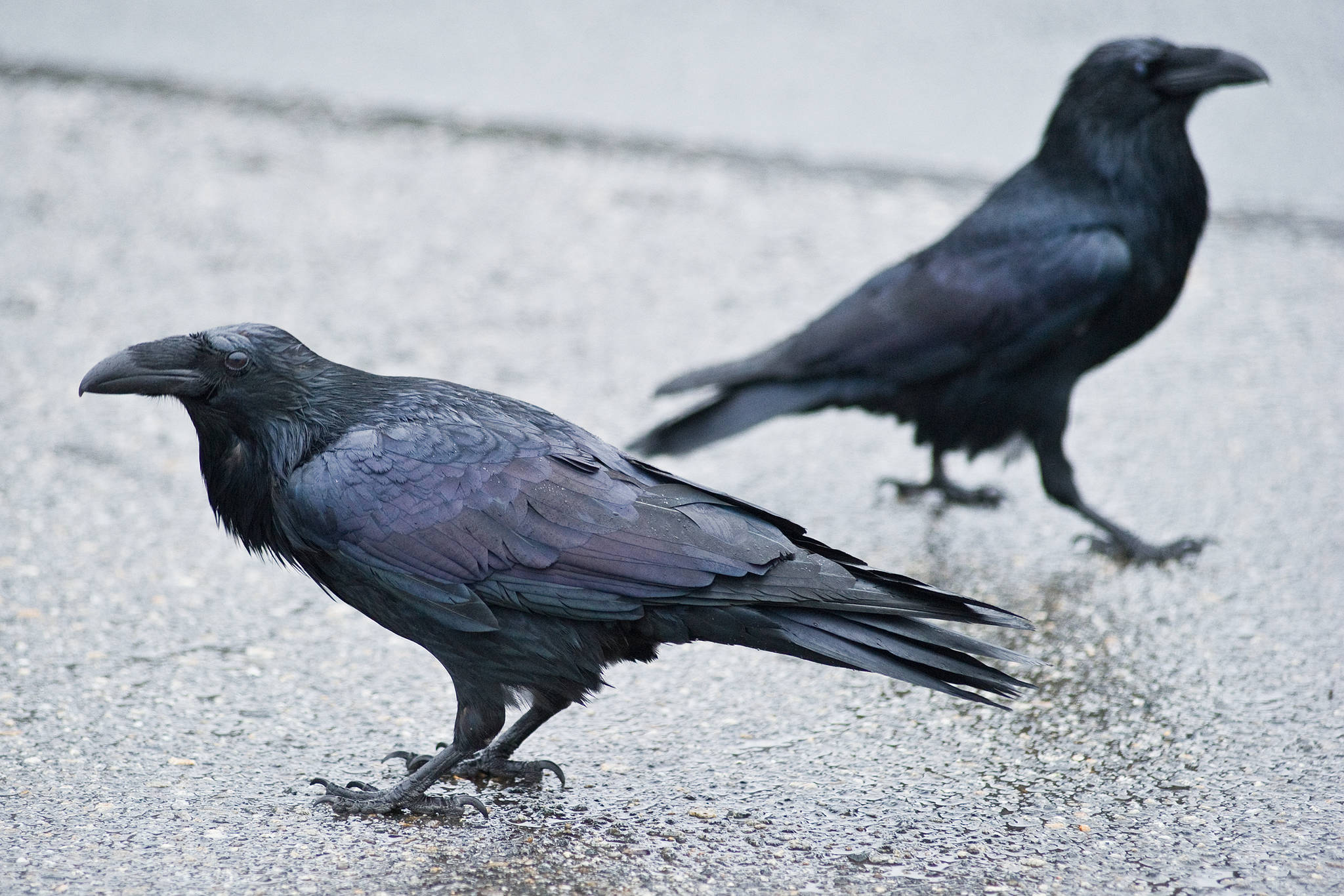We are accustomed to hearing about wolves or killer whales that hunt in cooperative packs. And sometimes, conspecific animals can work in pairs. In the marshes, where I worked long ago, I could sometimes watch two coyotes team-hunting ducks — one to keep the duck’s attention while the other crept up behind. And here, we can see eagles working as a team. One swoops down on a duck, which promptly dives, and the second eagle pounces as the duck resurfaces. Ravens also sometimes work in teams, one bird distracting an eagle that has a fish and the other one dashing in to snatch the fish.
Less well known are hunting partnerships between animals of different species. In a true partnership, both participants obtain some benefit, and that is sometimes difficult to demonstrate. Here are some proposed examples, often with insufficient documentation to make a solid case for a true partnership.
Wolves and ravens. Ravens are so often associated with wolves that they are sometimes called ‘wolf-birds’. When wolves kill a large animal, such as a deer, moose, or elk, they tear open the carcass, which allows ravens to scavenge lots of sizable tasty bits; without the opened carcass, the ravens are limited to snatching eyeballs and maybe part of the tongue. Wolf researchers have observed that travelling wolf packs are commonly followed by ravens, which clearly benefit from the more profitable scavenging.
But do wolves get anything from the attendant ravens? Some observers have claimed that ravens lead wolves to carcasses, but these claims may be more story than fact. One long-time wolf researcher noticed that when ravens accompany wolf packs, they would sometimes fly ahead, in the direction of travel, and wait for the wolves to catch up—which could appear to be leading the wolves. If a gang of ravens yells and calls when they discover a carcass, wolves could notice and might come; then both ravens and wolves could feast. The ever-observant ravens might alert feeding wolves to possible interlopers and disturbances, but how often this would be useful is not known. Maybe the potential value to wolves varies with conditions and location, and we should keep an open mind on this question, awaiting more research.
In an interesting twist on wolf-raven interactions, there are strong indications that the professional-level scavenging by ravens may be important in determining the size of wolf packs. A larger pack is better at fending off marauding ravens than a small pack, so more meat is available to the wolves. Of course, that’s also more wolfish mouths among which to divide the meat, but at least in some cases, the advantage of larger wolf numbers outweighs the disadvantage, so wolf packs are commonly bigger than two or three hunters.
Coyotes and badgers. A study in Wyoming found these two predators interacting in ways that suggested collaboration while hunting ground squirrels. Badgers hunt by digging into ground squirrel burrows, blocking off tunnels, and trapping prey in dead-ends, but sometimes the squirrels escape by emerging above ground. Coyotes there chase and pounce, although sometimes a squirrel dives into another tunnel system, there to be pursued by badger. The coyotes clearly benefited: they caught more squirrels when they were interacting with badgers. Because the badgers catch their prey underground, it is harder to tell what their hunting success might be, but they spent more time underground when they were interacting with coyotes and they might have been feasting. More data needed!
The apparently collaborative hunting typically involved single coyotes, not pairs or trios. They seemed to hear the badgers’ burrowing activity and solicit interaction by scrambling in a particular area or showing play behavior when the badger appeared. However, female badgers with young did not participate, rebuffing soliciting coyotes. The cooperative interaction occurred in sagebrush habitat where coyotes had limited mobility and where the sagebrush roots made badger digging somewhat difficult. Collaborative behavior was not observed where both critters had easy hunting or where coyotes are harassed and shot by humans.
Groupers and moray eels. Groupers are sizable predatory fish that live on coral reefs around the world; moray eels are predators that usually forage at night. Groupers sometimes hunt with moray eels, particularly if they are hungry (well-fed ones don’t do it), and an eel can be coaxed to forage during the daytime. A hungry grouper seeks out a moray eel that’s resting in a hole in the reef. It faces the eel, close-up, shaking its head and flicking its dorsal fin. If the eel is interested, out it comes. If the eel is reluctant to emerge, the grouper signals more vigorously. If the grouper manages to recruit the eel, the eel slithers in and out of crevices in the reef and the grouper lurks about nearby. When the eel flushes a small fish out into the open, the grouper may grab it—or chase it back into a hole where the eel can get it. If the prey fish gets away and hides, and if the grouper knows where it is, the grouper gives a more vigorous head-shake to the waiting eel and they may try again. Both animals feed well when they use this method.
The peacock grouper was introduced to Hawai’i from the Indo-Pacific region. Morays in Hawai’I respond to the foraging invitations of these foreigners, which apparently know how to behave as well as the native groupers. So a new association was established.
Groupers have also been seen signaling to octopuses, which may join in a hunt. They can insert their long tentacles into crevices and scare out the hiding fish. Grouper or octopus may catch the fish.
Honey guides and honey badgers. This is the classic, often-cited example of interspecific foraging partnerships. Honey guides are birds of Africa and Asia that have the unusual habit of feeding on beeswax and larvae, but they cannot open a tree cavity that houses bees. Honey badgers are tough weasel-like omnivores that love honey (and probably bee larvae), sometimes raiding domestic bee hives. Certain species of honey guides are said to lead badgers to bee colonies; the badgers rip them open to expose the comb, with its honey and larvae, and both animals feast. However, there is serious doubt about this collaboration; some scientists report that it is basically a myth, with no factual evidence. However, the honey guides do work with humans that will open the cavity, making the goodies inside available to both bird and human. Honey-hunters of some African tribes use special calls to bring honey guides into action. Obviously, these two interspecific interactions are not mutually exclusive, but the badger connection may need to be verified.
Hunting humans interact with many different animals in collaborative ways; of which, more next time.
• Mary F. Willson is a retired professor of ecology. “On The Trails” is a weekly column that appears every Wednesday.


